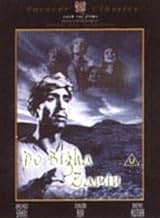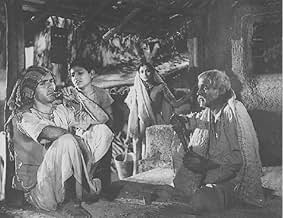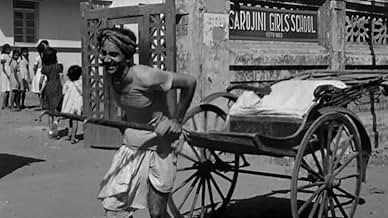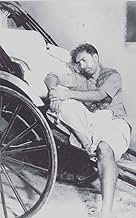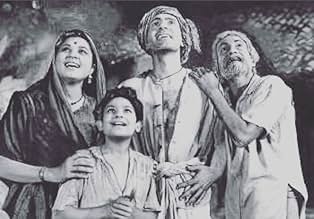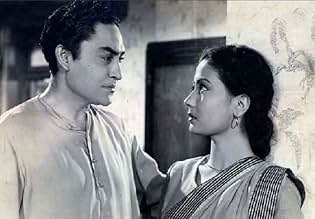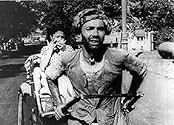Do Bigha Zamin
- 1953
- 2h 11min
CALIFICACIÓN DE IMDb
8.3/10
2.4 k
TU CALIFICACIÓN
Agrega una trama en tu idiomaIn the hope of earning enough money to pay off his debts and save his land, a poor farmer becomes a rickshaw puller in Calcutta and faces many difficulties.In the hope of earning enough money to pay off his debts and save his land, a poor farmer becomes a rickshaw puller in Calcutta and faces many difficulties.In the hope of earning enough money to pay off his debts and save his land, a poor farmer becomes a rickshaw puller in Calcutta and faces many difficulties.
- Dirección
- Guionistas
- Elenco
- Premios
- 4 premios ganados y 1 nominación en total
Ratan Kumar
- Kanhaiya Maheto
- (as Rattan Kumar)
Rajlakshmi Devi
- Nayabji
- (as Rajlakshmi)
Nasir Hussain
- Rickshaw puller
- (as Nazir Hussain)
Ramayan Tiwari
- Paro's molester
- (as Tiwari)
- Dirección
- Guionistas
- Todo el elenco y el equipo
- Producción, taquilla y más en IMDbPro
Opiniones destacadas
Bicycle Thieves is a very touching Italian movie. But this one is our own native version of that. With genuine plot and out-of-the-world cinematography, Do Bigha Zamin is Indian masterpiece.
The actors are terrific, totally portraying the characters given to them. Music, direction, screenplay & the execution is all marvelous. Even today, this works because it talks about poverty, life, emotions, relationships & virtues. Fantastic. Moreover, the intricacy with which details are kept in focus should be the USP of this film. 9.1/10.
BOTTOM LINE: Get that DVD right now. A must-watch.
Can be watched with a typical Indian family? YES
Profanity: No | Sex/Nudity: No | Violence: Very Mild | Gore: No | Alcohol/Smoking: No | Drugs: Mild (Hookah)
The actors are terrific, totally portraying the characters given to them. Music, direction, screenplay & the execution is all marvelous. Even today, this works because it talks about poverty, life, emotions, relationships & virtues. Fantastic. Moreover, the intricacy with which details are kept in focus should be the USP of this film. 9.1/10.
BOTTOM LINE: Get that DVD right now. A must-watch.
Can be watched with a typical Indian family? YES
Profanity: No | Sex/Nudity: No | Violence: Very Mild | Gore: No | Alcohol/Smoking: No | Drugs: Mild (Hookah)
Bimalda's Do Bigha Zameen is considered a gem in Indian movies. The movie has a slight socialist theme as did most movies of that time. If the younger generation of Chinese, Eastern Europeans and Russians wonder why they saw so many Indian movies this socialist theme, probably is the answer. Do Bigha Zameen won the first ever Filmfare award. The movie got a special mention at the Cannes film festival. The movie is about a farmer Shambhu (Balraj Sahni), who has been hit badly by a famine in Bengal. The real reason of his sorrow is that the Zamindaar (land owner) wants to acquire his land on the pretext that Shambhu had taken some loan from him. Shambhu has to pay back and hence he moves to the city.
The movie paints a very true picture of pre-independence (and early post independence) India. The society is agrarian yet the farmers are poor mainly because of the fact that they have very small land holdings and they are unlettered. The farmers were gullible while the land owner, money lender and the Brahmins were guile. A lot of people moved to the cities either in the anticipation of turning there fortunes or because they could not survive the atrocities of power holders. The movie has a theme that can be found in works of notable Indian authors Munshi Premchand or Sarat Chandra Chaterjee.
The most memorable scene from the movie is when Shambhu pushes himself to his limits pulling a hand pulled rikshaw. The rider on the riksha offers Shambhu more and more money to pull faster because he is chasing (probably) his girlfriend in another rikshaw. Note Shambhu's emotions, his smile in anticipation of getting more. Compare this with the rich class which is not worried the least about the lower class' plight. The lower class is no more then a machine that can be operated by putting in quarters. The rikshaw looses a wheel and Shambhu is injured.
This is the kind of movie that can not be spoilt even if I were to write the entire story down for you. This is art not suspense thriller. You must watch this movie not for the story but the direction and the acting abilities of Balraj Sahni and Nirupa Roy (Shambhu's wife).
In all these hardships Shambhu does not loose his righteousness which is the moral of the movie. Shambhu's son steals money to help his father only to be reproached by his father. Shambhu's morality is the only thing that remains his own till the end.
The movie is notable for Balraj Sahni's performance and since it is another of Bimal Roy's movies you can expect only the best. Personally I recommend any of the Bimal Roy movies. Like other movies by him, art and commercial form of cinema are merged to produce a movie that is still looked upon as a benchmark.
Finally the name of the movie means Two Bigha of Land. Bigha is a unit of measuring land. Bigha varies from state to state. In Bengal where the movie is based 3 Bigha is one Acre. So Shambhu owns only 2.7 sq. kilometres.
The movie paints a very true picture of pre-independence (and early post independence) India. The society is agrarian yet the farmers are poor mainly because of the fact that they have very small land holdings and they are unlettered. The farmers were gullible while the land owner, money lender and the Brahmins were guile. A lot of people moved to the cities either in the anticipation of turning there fortunes or because they could not survive the atrocities of power holders. The movie has a theme that can be found in works of notable Indian authors Munshi Premchand or Sarat Chandra Chaterjee.
The most memorable scene from the movie is when Shambhu pushes himself to his limits pulling a hand pulled rikshaw. The rider on the riksha offers Shambhu more and more money to pull faster because he is chasing (probably) his girlfriend in another rikshaw. Note Shambhu's emotions, his smile in anticipation of getting more. Compare this with the rich class which is not worried the least about the lower class' plight. The lower class is no more then a machine that can be operated by putting in quarters. The rikshaw looses a wheel and Shambhu is injured.
This is the kind of movie that can not be spoilt even if I were to write the entire story down for you. This is art not suspense thriller. You must watch this movie not for the story but the direction and the acting abilities of Balraj Sahni and Nirupa Roy (Shambhu's wife).
In all these hardships Shambhu does not loose his righteousness which is the moral of the movie. Shambhu's son steals money to help his father only to be reproached by his father. Shambhu's morality is the only thing that remains his own till the end.
The movie is notable for Balraj Sahni's performance and since it is another of Bimal Roy's movies you can expect only the best. Personally I recommend any of the Bimal Roy movies. Like other movies by him, art and commercial form of cinema are merged to produce a movie that is still looked upon as a benchmark.
Finally the name of the movie means Two Bigha of Land. Bigha is a unit of measuring land. Bigha varies from state to state. In Bengal where the movie is based 3 Bigha is one Acre. So Shambhu owns only 2.7 sq. kilometres.
This movie is a must see. It shows poverty with a humanistic approach in 1953 India. I went to Calcutta in 1999 and people still ride on human rickshaws (a person runs barefoot on streets while pulling the rickshaws for few cents). It is a very sad. It is heart breaking. In this movie get to see a common man problems and how he or she deals with it. It shows how corrupted the rich are and using the poor for their own means. This is how a 1/3 of India lives in today hi tech India. This is how people are suffering with all the economic boom India has. This is how people live in today's Independent and Free India. This movie is a must see.
This movie is a an Indian classic.... I don't know why so many people here are going on about how unrealistic it is...... I would wonder how many who commented as such have actually been to that part of India and witnessed the poverty there....
The story may well have been copied but the film is no doubt still great. I cant think of many other copies which are actually good. This film does actually touch you with its sadness, and claims of melodramaticness will be gladly tossed aside because we are talking about Indian cinema here...
All in all i think this is definitely a gem in Indian cinema, and fit the bill of an all time classic.
The story may well have been copied but the film is no doubt still great. I cant think of many other copies which are actually good. This film does actually touch you with its sadness, and claims of melodramaticness will be gladly tossed aside because we are talking about Indian cinema here...
All in all i think this is definitely a gem in Indian cinema, and fit the bill of an all time classic.
I have seen Do Bigha Zamin many times ( at least five ) but never had a chance to write a review. Every time I see this movie I put my hats off to Mr. Bimal Roy as the director of this masterpiece. I have read comments about having the idea from a different film ( Vittorio Di Sica's Bicycle Thief ) But I can challenge a lot of director to copy any film they want and produce something like Do Bigha Zamin. The scenes of a village in Bengal and the streets of Calcutta ( now Kolkata ) in early fifties are so real - it just sends shivers through my body. I was a student in a Calcutta college during that period and the scenes from Esplanade area, with Metro Cinema, Chowringhee Road, the double decker buses, the trams and finally the human rickshaws were presented in such a way that I felt being there in that period. The poverty of the villagers and as well as the bustee dwellers were very realistic and the characters were portrayed and played extremely well. Some of the scenes like when Paro went to Meena Kumari to get a letter written, the short scene where Nirupa Roy complaining to Balraj Sahni that he does not love her are very touching scenes. One of the other wonders are the boot polish kid Laloo. I don,t know whether he is an actor or real boot polish kid in real life , but he displayed a wonderful piece of acting as the friendly companion to Kanhaiya ( Rattan Kumar ). Nirupa Roy as the wife of the peasant Balraj Sahani, Balraj Sahani himself and Rattan Kunmar all played their parts very well. I should also mention the role played by Rajlakhsmi Devi as the Bustee owner - what can be more realistic than that. Though the economic scene in India has changed over the last sixty years still there are a lot of poverty in India and peasants like Shambhu Mahato can be found all over India. I appreciate the director's last scene where it shows the family is still intact with hope for the future at the same time the struggle for survival goes on as they lost their land to the greedy landlord. I have the DVD and will watch it many more times.
¿Sabías que…?
- TriviaWhen the shoeshine boys discuss seeing Nargis in El vagabundo (1951), one of them alludes to a shirt worn by a bystander. The shirt is decorated with a recurring pattern showing the famous scene from El vagabundo (1951) in which Raj Kapoor comes upon Nargis as she is changing clothes, partially hidden by a screen, after swimming. That scene occupies a place in Hindi cinema comparable to that of Deborah Kerr and Burt Lancaster on the beach in De aquí a la eternidad (1953).
- ConexionesFeatured in Century of Cinema: And the Show Goes On: Indian Chapter (1996)
- Bandas sonorashariyaala saawan dhol bajaata aaya
Sung by Lata Mangeshkar, Manna Dey
Selecciones populares
Inicia sesión para calificar y agrega a la lista de videos para obtener recomendaciones personalizadas
- How long is Do Bigha Zamin?Con tecnología de Alexa
Detalles
- Tiempo de ejecución2 horas 11 minutos
- Color
- Relación de aspecto
- 1.37 : 1
Contribuir a esta página
Sugiere una edición o agrega el contenido que falta

Principales brechas de datos
By what name was Do Bigha Zamin (1953) officially released in Canada in English?
Responda

